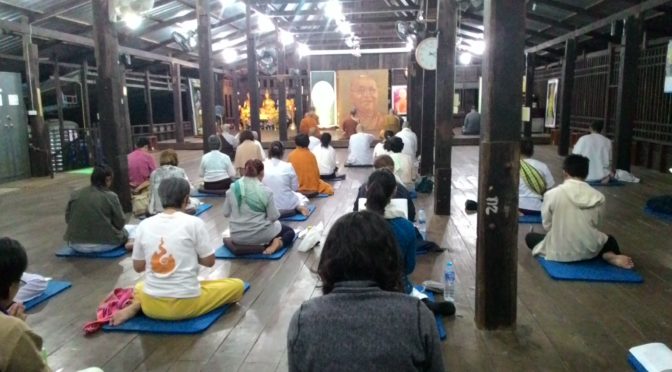This is a case study that is part of a series of linked posts:
Introduction, case 1 | 2 | 3 | 4 | 5
Case 5: Candasaro
Before ordaining as a monk in Thailand, Candasaro had worked at a private factory as a production manager in Sichuan for over 30 years. In 2008 he started exploring Theravāda meditation by learning observing the breath[i] with Pa-Auk Sayadaw’s method at Jiju Mountain for about two months in Yunnan. He later gave up this practice as he could not see any sign[ii] emerged in his sitting. “My personality is quite fast-paced. It’s difficult to cultivate calmness.”[iii] In May 2011, he firstly learnt about the practice of dynamic movement at a ten-day retreat led by Luangpor Khamkhian Suvanno, from Thailand, in Hongzhou.[iv] During the retreat, he tasted a sense of joy[v], a positive outcome of meditation.
Candasaro found that dynamic movement suited him perfectly. He explained about the practice: “In the beginning [you] observe the movement of the body. Later [you can] observe the mind. All practices are similar. They firstly cultivate calmness by bringing awareness to one point. That is developing an ability of concentrating the mind. Without calmness, it is impossible to practice vipassanā. When you open the six sense doors, you hold one of them, like a monkey holding the main pillar. In dynamic movement, the main practice is moving the arms. In Mahāsi’s method, it is about the rising and falling of the abdomen. … I like observing the movement.”
He also practiced the dynamic movement at workplace. “While I was working at the control room, I managed the office work and communicated with my colleagues [when it was necessary]. The workload was not so heavy. There was only about one working our every day. It was relaxing.” Then in October 2011 Candasaro joined an organized trip to stay at WatPa Sukato[vi] for two months in South Thailand. This was the first time he travelled to Thailand. Located at Chaiyaphum Province, the temple covering an area of 185 acres, including a river and Phu Kong Mountain that was 470 meters above sea level. Sukato means ‘good’. Luang Phor Kham Khian Suwanno, the first abbot, shared his intention of building the temple, “Sukato is a place where people come and go for wellness, also for the beneficial impact of the environment, human being, river, forest and air. This is the wellness in coming, going and being. This wellness is born from earth, water, air and fire, not from one person alone. …There are shelter, food and friends who will teach, demonstrate, and give advice. Should one wish to stay here, his or her intention to practice dharma shall be fulfilled.”[vii]
In this huge forest temple, there were around 30 monks and 30 lay people only. As there were plenty established huts, every resident could stay in one hut.[viii] Every morning, all residents woke up at 3 o’clock in the early morning to prepare for the chanting and dhamma talk at 4 o’clock. Around 6 am, Candasaro and other monks, dressed in yellow monastic robe, formally visited villages nearby carrying their alms bowls for their daily alms round. (See Fig. 3 and Fig. 4) In Chinese Buddhist communities in China, alms round practices have been faded out for many centuries. With bare feet, the monks lined up tidily first and started walking towards one of the target villages. After entering the village, they stopped in front of a household where donors were waiting with cooked rice and food. Whenever people from households offered food to monks one by one, they would line up before the householders and chant blessing words in Pāli. All the monks went back to the monastery with the received alms. At around 7.30 am, volunteers in the monastery kitchen finished preparing the foods so that the monks and all residents could have their first meal. For monks, this was also the only meal according to their precepts.
In August 2012, he stayed there again for a month. In 2013, he decided to quit his job and receive early retired pension. He decided to ordain as a bhikkhu and settled at WatPa Sukato. He enjoyed his monastic life very much, “I don’t need to spend any money by living at a monastery. I have been working in government and business sectors for many years. I am very tired of them. And my wife agreed to that [the separation] …. After you practice diligently, awareness lead you to have a strong sense of renunciation from the mundane world. Firstly, [it’s] renunciation; secondly, you do not attach or crave something.” (See Fig. 5)
Although Candasaro could not speak English, he had learnt some basic Thai words to communicate with Thai people for his daily basic needs. Over the past four years, he went back to China a few times to attend retreats and also invited some friends to travel to WatPa Sukato. In 2017, he returned to China and settled in Fujian Province. He started teaching dynamic meditation and led alms round in the village.
[i] Ch. guanhuxi; P. ānāpānasati.
[ii] Ch. chanxiang; P. nimitta.
[iii] Ch. ding; P. samādhi.
[iv] Luangpor Khamkhian Suvanno was a disciple of Luangpor Teean.
[v] Ch. xi; P. piti.
[vi] See “Wa-Pa-Sukato,” Tourism Authority of Thailand, https://www.tourismthailand.org/Attraction/Wat-Pa-Sukato–3354
[vii] Ibid.
[viii] Ch. gudi; P. kuṭi
